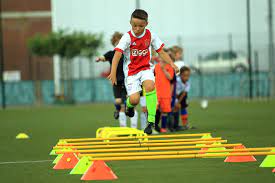
Fitness is a crucial aspect of football performance, as the sport demands a combination of aerobic endurance, strength, speed, agility, and flexibility. Players need to be physically prepared to meet the demands of the game, which involves running, sprinting, changing direction, and various strength and power movements. Here’s a comprehensive guide to fitness for football:
1. Cardiovascular Endurance:
- Running: Develop aerobic fitness through steady-state running to build a strong cardiovascular base.
- Interval Training: Incorporate high-intensity interval training (HIIT) to improve anaerobic fitness, mimicking the stop-and-start nature of the game.
2. Strength Training:
- Compound Movements: Emphasize compound exercises like squats, deadlifts, and bench presses to build overall strength.
- Functional Strength: Include exercises that mimic football movements, such as lunges, step-ups, and medicine ball throws.
- Core Strength: Strengthen the core to enhance stability and reduce the risk of injuries.
3. Speed and Agility:
- Sprint Training: Integrate sprint drills to improve acceleration and top-end speed.
- Agility Drills: Incorporate agility ladder drills, cone drills, and shuttle runs to enhance quick changes of direction.
4. Flexibility and Mobility:
- Dynamic Stretching: Include dynamic stretching in warm-up routines to improve flexibility and range of motion.
- Static Stretching: Incorporate static stretches in cool-down sessions to promote flexibility and reduce muscle tightness.
5. Power and Explosiveness:
- Plyometrics: Integrate plyometric exercises like box jumps, bounding, and explosive squats to develop power.
- Olympic Lifts: Include Olympic lifts such as cleans and snatches to improve explosive strength.
6. Endurance Conditioning:
- Sport-Specific Drills: Incorporate football-specific drills that mimic game scenarios to improve endurance conditioning.
- Small-Sided Games: Use small-sided games in training sessions to simulate match conditions and enhance endurance.
7. Recovery and Regeneration:
- Proper Nutrition: Ensure players have a balanced diet with an emphasis on carbohydrates, proteins, and adequate hydration.
- Rest and Sleep: Prioritize sufficient rest and quality sleep to allow for proper recovery.
8. Injury Prevention:
- Prehab Exercises: Include prehabilitation exercises to strengthen vulnerable areas and prevent common football injuries, such as those affecting the knees and ankles.
- Warm-Up and Cool Down: Implement thorough warm-up routines before training and matches, and cool down sessions afterward.
9. Position-Specific Conditioning:
- Positional Drills: Tailor conditioning drills to specific positions, considering the different physical demands placed on forwards, midfielders, defenders, and goalkeepers.
10. Periodization:
- Seasonal Planning: Implement a periodized training program that varies intensity and volume throughout the season to peak for important matches and maintain overall fitness.
11. Mental Conditioning:
- Visualization: Incorporate mental conditioning techniques, such as visualization, to enhance focus, confidence, and mental resilience.
- Match Simulations: Include realistic match simulations in training to mentally prepare players for the pressures of competition.
12. Monitoring and Assessment:
- Fitness Testing: Regularly assess players’ fitness levels through various tests to track progress and identify areas for improvement.
- Player Feedback: Encourage players to provide feedback on their perceived fitness levels and recovery status.
13. Adaptability:
- Adapt Training: Be adaptable in training approaches, considering individual differences, injuries, and the specific needs of the team.
A comprehensive and well-structured fitness program is essential for football players to perform at their best and minimize the risk of injuries. Tailoring training to address the specific physical demands of football contributes to overall player development and success on the field.
